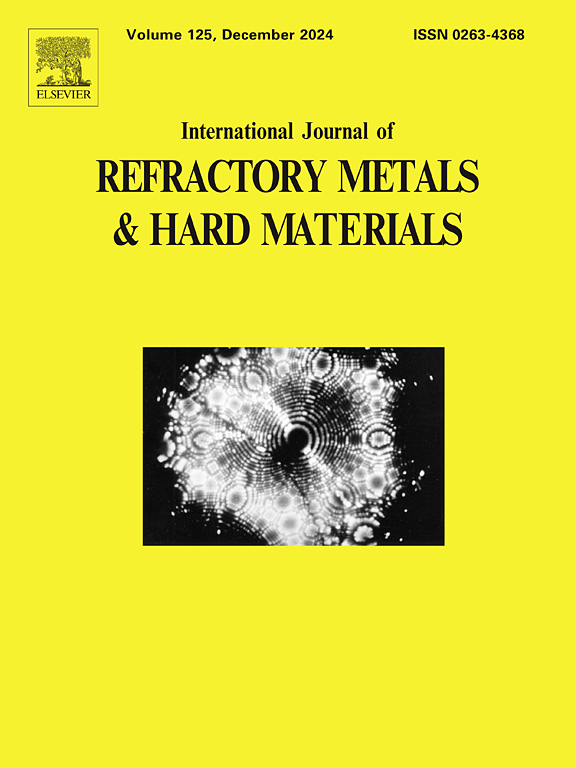Effect of Nb low-alloying on the microstructure, corrosion and wear performance of a Co-28Cr-6Mo alloy fabricated by Vacuum Arc Melting
IF 4.2
2区 材料科学
Q2 MATERIALS SCIENCE, MULTIDISCIPLINARY
International Journal of Refractory Metals & Hard Materials
Pub Date : 2025-07-14
DOI:10.1016/j.ijrmhm.2025.107330
引用次数: 0
Abstract
This study investigates the effect of small Nb additions on the microstructure, corrosion and sliding wear performance of Co-28Cr-6Mo-xNb (x = 0, 1, 2, 3 wt% Nb) alloys fabricated by Vacuum Arc Melting (VAM). The alloys featured a dendritic structure with a Co-based matrix (a mixture of FCC-Co and HCP-Co) and intergranular eutectic C14-Laves Nb(Cr,Co)2 co-located with (Nb,Mo,Cr)C carbides, along with minor amounts of Nb2O5. Increasing the Nb content refined the microstructure and increased the amounts of Nb-based hard phases and HCP-Co. Nb was confined to the interdendritic spaces, whereas Mo preferentially segregated there. All compositions showed very low uniform corrosion rates (order of 10−4 mA/cm2), true passivity and very high resistance to localized corrosion in simulated body fluid at 37 °C during cyclic potentiodynamic polarization, with the 2 wt% Nb-alloy demonstrating the lowest corrosion kinetics. Very low dry sliding wear rates (ball-on-disk test) were measured (order of 10−7 g/Nm), notably decreasing with increasing Nb content. In view of these findings, VAM proved to be a suitable method for fabricating these alloys.

Nb低合金化对真空电弧熔炼Co-28Cr-6Mo合金组织、腐蚀和磨损性能的影响
研究了微量Nb对真空电弧熔炼(VAM) Co-28Cr-6Mo-xNb (x = 0,1,2,3 wt% Nb)合金组织、腐蚀和滑动磨损性能的影响。该合金具有枝晶结构,由Co基基体(FCC-Co和HCP-Co的混合物)和沿晶共晶的C14-Laves (Nb (Cr,Co)2和(Nb,Mo,Cr)C碳化物共晶,以及少量的Nb2O5组成。Nb含量的增加细化了组织,增加了Nb基硬相和HCP-Co的数量。Nb被限制在枝晶间隙,而Mo则优先在那里分离。在循环动电位极化过程中,所有成分均表现出非常低的均匀腐蚀速率(10 - 4 mA/cm2数量级)、真正的钝化和非常高的抗局部腐蚀能力,其中2 wt%的铌合金表现出最低的腐蚀动力学。干滑动磨损率(球盘测试)很低(10 ~ 7 g/Nm量级),随着Nb含量的增加而显著降低。鉴于这些发现,VAM被证明是制造这些合金的一种合适的方法。
本文章由计算机程序翻译,如有差异,请以英文原文为准。
求助全文
约1分钟内获得全文
求助全文
来源期刊
CiteScore
7.00
自引率
13.90%
发文量
236
审稿时长
35 days
期刊介绍:
The International Journal of Refractory Metals and Hard Materials (IJRMHM) publishes original research articles concerned with all aspects of refractory metals and hard materials. Refractory metals are defined as metals with melting points higher than 1800 °C. These are tungsten, molybdenum, chromium, tantalum, niobium, hafnium, and rhenium, as well as many compounds and alloys based thereupon. Hard materials that are included in the scope of this journal are defined as materials with hardness values higher than 1000 kg/mm2, primarily intended for applications as manufacturing tools or wear resistant components in mechanical systems. Thus they encompass carbides, nitrides and borides of metals, and related compounds. A special focus of this journal is put on the family of hardmetals, which is also known as cemented tungsten carbide, and cermets which are based on titanium carbide and carbonitrides with or without a metal binder. Ceramics and superhard materials including diamond and cubic boron nitride may also be accepted provided the subject material is presented as hard materials as defined above.

 求助内容:
求助内容: 应助结果提醒方式:
应助结果提醒方式:


